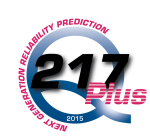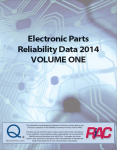RMQSI Knowledge Center
DATA CALL
Field Failure Rate Data for Electronic Components
The RMQSI Knowledge Center™, operated by Quanterion Solutions, is currently working to update the Electronic Parts Reliability Data (EPRD-2014) databook, and the component models for its 217Plus™:2015 System Reliability Assessment methodology. We are inviting our user community to assist us by providing quantitative field failure rate data and/or mode/mechanism distribution data for electronic components.
What component types are you looking for data on? We’re looking for field reliability data on all types/technologies of the following components. The more recent and state-of-the-art, the better!
 Microcircuits
Microcircuits
Discrete Semiconductors
Photonics (components or modules) and Optoelectronics
Inductive Devices
Capacitors
Resistors
Connectors, Switches and Relays
Collecting/analyzing data requires a lot of resources! What’s in it for me or my company? Potentially a lot, but first, it’s important to understand that we do not pay for data. The “rewards” depend on the type, amount and quality of data that you provide on a one-time basis, or periodically over the long term. In the past, we’ve rewarded data contributors with:
- Reliability engineering analysis of its field data (certain restrictions apply)
- Free copies of our reliability databooks, handbooks or guides (such as the System Reliability Toolkit-V)
- Free access to on-line data (such as ROADS) and/or on-line training (such as REPERTOIRE)
- Discounts on certain products
We tailor our “thank you” rewards on a case-by-case basis, based on a mutually beneficial relationship.
What are the major data elements that you need? In order to be able to use your data:
- We need data at the piece-part level. If it’s at the product/equipment/LRU (end-item) level, it needs to be translated down to the part level. Bills of Materials (BOMs) can help, especially if your end item is used in certain US Department of Defense systems. In order for them to be useful, however, they will need to include either the commercial part numbers or a suitably detailed generic part description. Unfortunately, we can’t work solely with your unique internal spec control drawing numbers.
- We need the number of field operating hours and failures associated with each part in your end item. This may be as “simple” for you as creating a timeline of operating hours/failures for the end item and providing us with the necessary BOMs.
- Failures need to be identified at the part level, not the end-item level. We also need to be able to distinguish between actual failures (including root failure cause) and unrelated part replacements.
- We need information about the quantitative field environmental stresses on your end item. Typical environments are temperature (steady-state and min/max cycling), humidity, and vibration. If you don’t have “actuals”, we may be able to work something out.
- For each part failure, we would like to know the specific failure mode/mechanism associated with the root failure cause.
Of course, there are many nuances associated with the data that you have and the data that we need. We can discuss those in more detail at the appropriate time.
What’s the process for getting started? After an initial screening, and to protect you (and us), we ask that you send us your company’s Nondisclosure Agreement (NDA) form. When we mutually agree to the terms, the fully executed NDA will permit discussion of the specifics of what you are willing to provide.
We will need a sample of your data, and discuss the logistics of how you would submit it, in what format, how often, etc.
Once that is defined, we would let you know what we can offer in return.
Confidentiality of our data (and where it comes from) is critical. What steps do you take to protect data that I send you? We’re very sensitive to the need to protect your data! We have decades of experience in doing just that through the recent publication of our NPRD-2016 and FMD-2016 databooks, our previous core operation of the DoD Reliability Information Analysis Center (RIAC), and our experience with the RIAC predecessor Center (the Reliability Analysis Center – RAC).
Any detailed data submitted by you is held in strictest confidence. When we use the data for our products or models, it’s “scrubbed” so that there is no attribution or traceability of data to who submitted it, what products or systems it came (whether developed by you or your customers), or even down to the component manufacturer’s name, if appropriate. Don’t worry. If your failure data looks “bad”, we’d still like to use it, but nobody will ever see where it came from! Any limitations on what must be kept proprietary will be spelled out and agreed to in the NDA before any data changes hands.
How do I contact you to start the process? Before you go to any trouble of sending your NDA, please send us a brief description of the type of data you have and how often you would be able to submit it, as well as how much data there is (and over what period of time), what electronic components it covers, and what you might like to receive in return for your data. This information can be submitted to us at data@rmqsi.org. Don’t include proprietary data or information in this initial contact! If what you’ve sent us seems reasonable, we’ll respond to you requesting your NDA or additional information prior to moving forward. It’s as easy as that!
All of this sounds great, but we don’t have the resources to analyze the data. Is there any way you can help us? We’ve applied our experience and expertise in reliability data collection/analysis for many years under the Reliability Information Analysis Center (RIAC) and our NPRD-2016 and FMD-2016 publications. We offer paid consulting services that can help you make sense of your current data, or provide guidance on setting up databases to implement or enhance your own data collection/analysis processes in the future. If this interests you, please submit your request to data@rmqsi.org.
We look forward to hearing from you and potential opportunities to work together!

